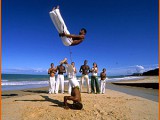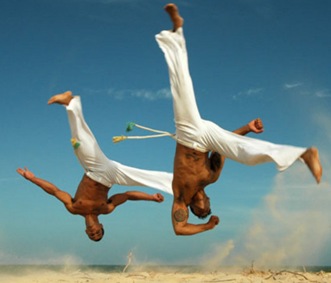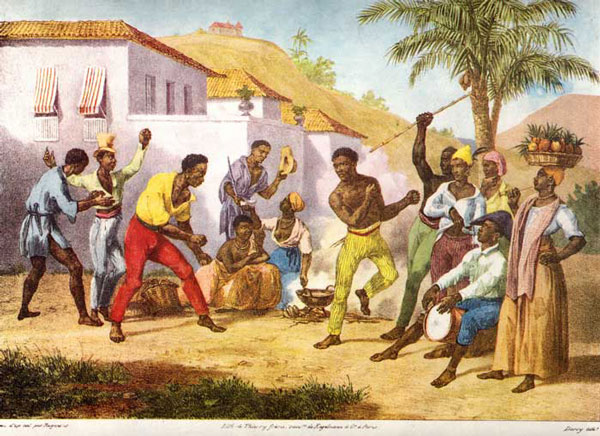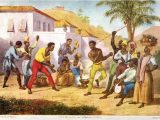Este post também está disponível em:
Português
English

The history of capoeira begins in the 16th century, when Brazil was a colony of Portugal.
African slave labour was used extensively in Brazil, especially in the engenhos (sugar-producing farms) of north-eastern Brazil. Many of these slaves came from the region of Angola, also a Portuguese colony.
In Africa, the Angolans performed many dances to the sound of music.
The well-known Capoeira, which is seen on the streets and hillsides of Salvador, has its history related to oppression and culture. This is how this dance or martial art, whatever you want to call it, came about.
Slavery in Brazil began around 1538 and with the arrival of these Africans, the customs they brought with them were a way of minimising their suffering in the New World.
The religious rituals and commemorative dances performed in their homeland already showed the first steps that would culminate in Capoeira.
It really came into being soon after the first slave escapes. Thus, the fugitives needed something to defend them and give them the ability to attack the “captains of the bush”.
And with ginga movements, jumps and kicks, the once commemorative dance took on the character of a fight.


Demonstração de Capoeira

Exibição de Capoeira

História da Capoeira06:21

Capoeira uma breve história11:50

Capoeira história e características08:57
Effectiveness of capoeira
The effectiveness of capoeira came in the form of victory in various battles, whether against the social oppression of the time or in wars like Paraguay.
The world-famous name originates from the “capoeiras”, or plots of land that have had the undergrowth burnt off and are growing vegetation.
It was in these areas that slaves found favourable conditions to fight for freedom and life.
Capoeira at the time of slavery
Capoeira had such an influence during the time of slavery and in the years that followed after abolition, that it was even banned under penalty of imprisonment or even deportation. Its practitioners were considered unoccupied and disorderly.

The diversity that exists in Bahia is also embedded in capoeira, which has 3 variations of fighting styles, music and songs.
The first style of capoeira emerged along with its development during slavery.
Capoeira Angola, as it is known, corresponds to one of the characteristics of Bantu African culture, which are some of its religious rituals.
Capoeira Angola
The game of capoeira Angola is full of wit, mandinga and elegant movements that follow the rhythm played by the orchestra. One of the best known masters of capoeira Angola is Vicente Ferreira Pastinha – Mestre Pastinha.
A disciple of the African master Benedito, Pastinha dedicated his life to teaching capoeira at his academy in the Pelourinho (Capoeira Angola Sports Centre), dedicating himself above all to undoing the prejudice against capoeira ingrained in society.
In the 1930s here in Bahia, Manoel dos Reis Machado – Mestre Bimba – after 14 years of being surrounded by the teachings of Capoeira Angola, and in view of the shortcomings of this modality, decided to create Luta Regional Baiana.
And today the well-known Capoeira Regional is a perfected line of Capoeira Angola, with around 52 moves.
It was Mestre Bimba who, through his new line of capoeira teaching, managed to include women and later white people from other social classes.
He also demanded that his capoeiras be working or studying, and even demanded that they all play in white uniforms as a form of hygiene.
Capoeira’s history shows that it was yet another way for slaves and their descendants to assert their identity and culture in a prejudiced society.
Brazil’s newest Cultural Heritage is practised in the streets of the Historical Centre of Salvador, where there are several academies, as well as in the traditional capoeira roda at the Mercado Modelo and everywhere else in the city there is a capoeira academy or group waiting with open arms for new and old followers.
Three styles of capoeira
Capoeira has three styles that differ in their movements and accompanying musical rhythm.
Oldest style
The oldest style, created during the time of slavery, is capoeira angola. The main characteristics of this style are: slow musical rhythm, blows thrown low (close to the ground) and a lot of malice.
Regional style
The regional style, created by Mestre Bimba, is characterised by a mixture of the malice of capoeira angola and fast movements to the sound of the berimbau.
The blows are quick and dry, and acrobatics are not used.
Contemporary style
The third type of capoeira is contemporary, which combines the first two styles.
This last style of capoeira is the most widely practised today. However, it’s important to emphasise that there is only one capoeira, Capoeira de Angola, considered the mother of the other styles and closest to the capoeira played by African slaves.
Bahia.ws – Tourism and Travel Guide to Salvador, Bahia and the North East



















